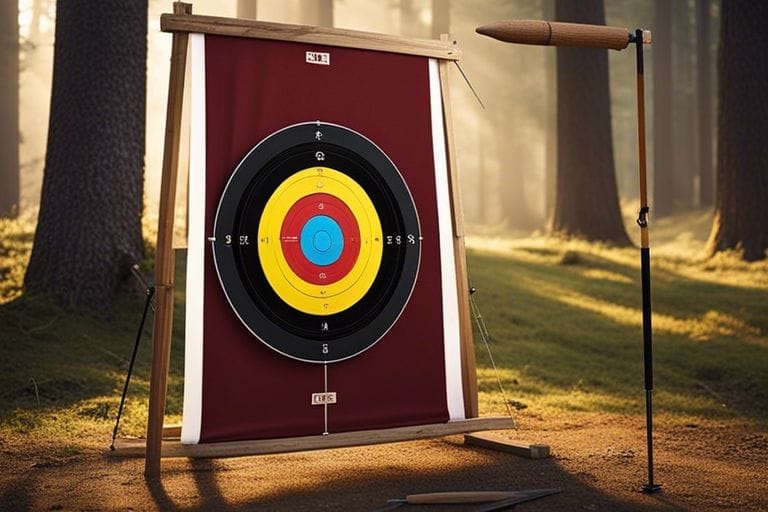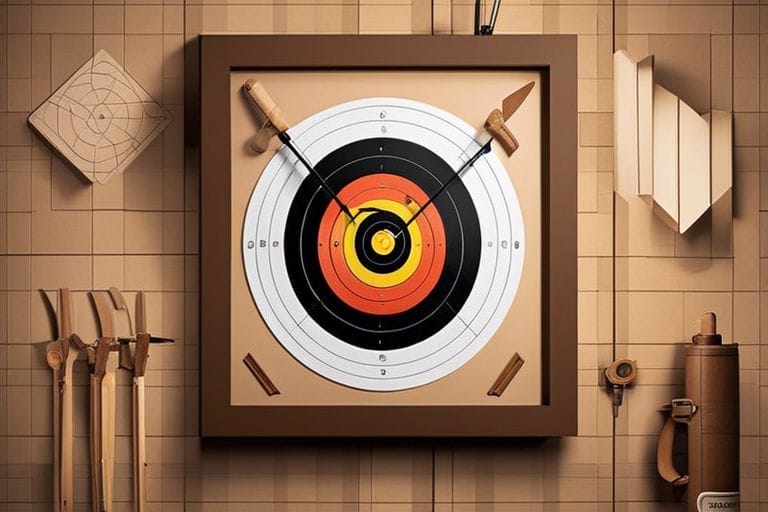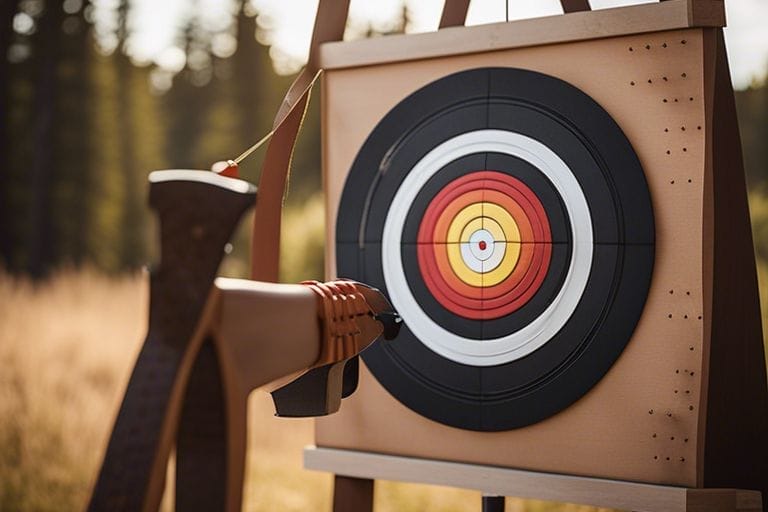If you’re an avid archer, having a reliable and durable target is essential for practicing your aim and improving your skills. Commercial archery targets can be costly, but with a few simple materials and some DIY know-how, you can create your own homemade archery target that is both effective and budget-friendly. In this guide, we’ll walk you through the step-by-step process of making your own archery target, including the materials you’ll need, the construction process, and tips for ensuring a long-lasting and effective target. By the end of this post, you’ll have all the knowledge and confidence you need to create your own personalized archery target that will help you hone your skills and enjoy hours of target practice.
Key Takeaways:
- Materials: Use cardboard, hay, and a sturdy frame to create a durable homemade archery target.
- Assembly: Cut the cardboard into circles, stack and secure it within the frame, and cover the front with hay for a functional target.
- Size and Storage: Consider the size of the target based on your shooting range and find a suitable place to store it when not in use to prolong its lifespan.
Materials and Tools
If you are planning to make your own homemade archery target, you will need to gather the necessary materials and tools before getting started. In this chapter, we will discuss the materials you should consider using, as well as the essential tools required for the assembly process.
Choosing the Right Materials
When it comes to selecting the right materials for your homemade archery target, there are a few important factors to consider. First and foremost, you will need a durable and dense material that is capable of stopping arrows effectively. Popular options include dense foam, straw, or tightly packed rags. You will also need a sturdy backing material, such as plywood, to hold everything in place. Consider the available space and your budget when deciding on the materials for your archery target.
Essential Tools for Assembly
Once you have gathered the necessary materials, you will also need a set of essential tools to help you with the assembly process. Some of the tools you will need include a saw for cutting the materials to size, a staple gun for securing the backing material, and a utility knife for trimming and shaping the target. Additionally, you may need a drill to create holes for hanging or mounting the target, as well as measuring tape and a marker for accurate placement of the materials.
Designing Your Target
The process of designing your homemade archery target is crucial in ensuring that it meets your specific needs and preferences. Whether you are an experienced archer or a beginner, the target should be designed to withstand the force of the arrows and allow for easy retrieval.
Target Dimension Considerations
When designing your homemade archery target, you must consider the dimensions of the target. The typical target size for archery is 48 inches in diameter and 6 inches in depth. This size allows for a large enough surface area to aim at while also providing enough depth to stop the arrows effectively. However, you may adjust the dimensions based on your shooting preferences and available materials. It’s important to ensure that the target is large enough to serve its purpose while being manageable to transport and set up.
Durability Features
When designing your homemade archery target, you should focus on incorporating durability features to ensure its longevity. Using high-density foam or multiple layers of dense materials can help prevent the arrows from penetrating through the target. Additionally, you can consider adding a weatherproof cover to protect the target from the elements, prolonging its lifespan. By reinforcing the target with durable materials, you can ensure that it can withstand continuous use and impact from arrows, making it a worthwhile investment for your archery practice.

Construction Steps
For the construction of your homemade archery target, you will need to follow a few key steps to ensure a sturdy and effective finished product. Below, we will outline the construction process, including building the frame, adding the backstop material, creating the target face, and performing assembly and safety checks.
Building the Frame
When building the frame for your homemade archery target, you’ll want to start by cutting your lumber to the desired dimensions. Typically, a simple rectangular frame will suffice, with crossbars for added stability. Once your pieces are cut, you can assemble them using screws or nails. Be sure to double-check that your frame is square before attaching the backstop material.
Adding the Backstop Material
After constructing the frame, it’s time to add the backstop material. This is a crucial step in ensuring that your homemade archery target effectively stops incoming arrows. You can use materials such as foam insulation board, densely packed straw, or layered cardboard. Secure the backstop material to the frame, ensuring that it is flush and free of gaps.
Creating the Target Face
With the backstop material in place, you can now create the target face. This can be done using a variety of materials, such as paper targets, fabric, or even paint directly onto the backstop material. Ensure that your target face is securely attached to the frame and offers clear visibility of the target area.
Assembly and Safety Checks
Once your homemade archery target is fully constructed, take the time to perform assembly and safety checks. Ensure that all components are securely attached and that the target face is free of any obstructions. Additionally, check for any potential safety hazards in the surrounding area, such as nearby objects that could interfere with arrow trajectory. Finally, conduct a thorough inspection of the target to make sure it is safe for use.
Usage and Maintenance
Keep your homemade archery target in good condition by following these tips. For more detailed instructions on how to make an archery target, refer to this step-by-step guide.
Proper Usage of Your Homemade Archery Target
When using your homemade archery target, make sure to place it on a flat, stable surface. This will prevent it from tipping over or shifting during use. Additionally, always inspect your target for any signs of wear and tear before each use. Proper usage will ensure the longevity of your target and keep it in good shape for years to come.
Tips for Maintaining Longevity
To maintain the longevity of your homemade archery target, consider the following tips:
- Store your target in a cool, dry place when not in use to prevent moisture damage.
- Rotate the target regularly to distribute the wear evenly across the surface.
- Inspect the target regularly for any signs of damage, such as holes or tearing.
Assume that by following these maintenance tips, you will extend the lifespan of your homemade archery target and ensure optimal performance.

Conclusion
Considering all points, making a homemade archery target is a cost-effective and straightforward way to enhance your archery skills. By following the simple steps outlined in this guide, you can create a durable and effective target that will help you improve your accuracy and precision. Whether you are a beginner or an experienced archer, having a homemade target at home will allow you to practice at your convenience, ultimately leading to better performance in the field or on the range. So, gather your materials and get started on constructing your very own archery target today!
FAQ
Q: What materials do I need to make a homemade archery target?
A: You will need a large piece of durable fabric such as canvas or burlap, a foam block, straw or cardboard tubes, adhesive, and a saw or sharp utility knife. Additionally, you may also want to gather some old newspapers or plastic bags for stuffing.
Q: How do I construct a homemade archery target?
A: First, cut your foam block or cardboard tubes into manageable pieces and lay them out in a pattern on your fabric. Then, begin adhering the pieces to the fabric using the adhesive, ensuring that they create a uniform and dense target surface. Once the core is constructed, stuff the surrounding area with old newspapers or plastic bags to provide additional stopping power for arrows. Finally, wrap the fabric tightly around the core and secure it in place, creating a smooth and taut surface for arrow penetration.
Q: How do I maintain and prolong the life of my homemade archery target?
A: To keep your homemade archery target in top condition, regularly inspect the fabric and core for signs of wear and tear. If the fabric becomes loose or the core begins to degrade, consider rewrapping the target with a new fabric cover or adding additional stuffing to the core. Additionally, be sure to rotate the target regularly to distribute wear evenly, and store it in a dry, cool place when not in use to prevent moisture damage. With proper care, your homemade archery target can provide countless hours of practice and enjoyment.


